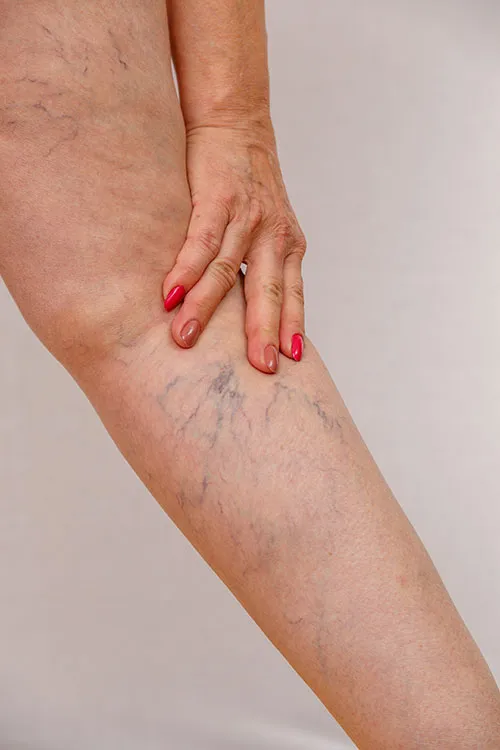


Why consider miraDry? MiraDry Reviews Treatment DetailsFees Why Choose MiraDry Team Frequently Asked Questions
Varicose veins are twisty, swollen veins with a raised appearance, which usually develop in the legs and feet. These veins are an indication of an underlying cause that can be treated with minimally invasive techniques, such as endovenous laser ablation.
Typically, the NHS will only treat varicose veins in extreme cases, where varicose ulcers are present, or if the patient is in extreme pain. Varicose veins that the NHS refuse to treat may still be significantly painful, aesthetically displeasing, and impact your daily life.
Treatment at Kat & Co targets the underlying cause of varicose veins, restoring proper circulation to your legs. EVLA is a minimally invasive procedure, meaning general anaesthetic and surgery are not required. Treatment typically takes around 2 hours, and you are free to go home the same day and continue normal activities and work.
For some people, dealing with the symptoms of varicose veins is tolerable. You may only have minor aesthetic concerns. However, varicose veins tend to worsen over time, causing increased pressure on the skin with the risk of painful ulcers and further symptoms. Healthy lifestyle choices such as regular exercise and a healthy diet can reduce the impact of varicose veins and may prevent them from worsening. Treatment will be required to fully relieve existing symptoms.
The treatment you require will highly depend on the root cause of your issues. To determine this, your consultant will use a doppler ultrasound scanner to determine the blood circulation in your legs and identify any affected veins. EVLA, combined with foam sclerotherapy, will treat both the underlying cause and aesthetic implications of varicose veins. If your condition is minor, you may only require foam sclerotherapy to ease symptoms and improve the appearance of visible veins.
Traditionally, varicose veins were treated with a surgical operation to remove the problem

veins. This procedure is invasive, requiring general anaesthetic, incisions, stitches, and a long recovery time off work. Although this surgery was relatively effective, many patients reported recurrence or further problems. Endovenous laser ablation (EVLA) has been recommended by NICE (the National Institute for Health and Care Excellence) since 2014, with an over 95% success rate (JVIR).
EVLA is a minimally invasive procedure, performed under local anaesthetic, which typically takes between 1 and 2 hours, depending on the number of veins which need treatment. EVLA is not normally painful, although it might be slightly uncomfortable, and requires no downtime following the procedure.
An ultrasound will be performed prior to your treatment to identify the problem veins that are causing your varicose veins. You will be provided with all information relating to your procedure, including alternative treatment options, risks/complication and success rates. You will be required to sign an informed consent form prior to your treatment.
Throughout the procedure the ultrasound scanner will be used to give your consultant a view of your veins.
Local anaesthetic will be injected to numb the surrounding area and a needle will be placed into the vein which needs treating. A thin wire will be passed through the needle and into the vein. It is then covered by a plastic sheath, removed, and the laser fibre is inserted in its place.
Once everything is in position, local anaesthetic will be applied along the length of the vein to numb the whole leg and protect the surrounding tissue from damage. The laser will then be turned on, providing a powerful beam of energy which heats up the wall of the vein. The laser fibre will be pulled slowly back through the vein, heating up the surrounding vein wall and destroying it. This process typically takes between five and ten minutes per vein.
Following your procedure, you will be helped to put on a compression garment (stocking(s)) by the nurse. They will teach you how to wear these and let you know what to look out for during your recovery. You will be asked to take a brief walk after your treatment. You will not be allowed to drive home following your appointment, but you can drive the following day. Additionally, long haul flights (over 4 hours) are prohibited for 4 weeks after your procedure.
You will be required to wear your compression stocking for at least a week. You will not be able to go swimming, horse riding, or lift heavy weights during this period. You may experience a sensation of tightness over the next few weeks as the vein shrinks. Bruising is also highly likely. This is typically minor but can be quite significant. This will normally reduce after a week or so.
Most patients will experience little or no pain, and can return to work and normal activities immediately. Some patients may experience significant pain and have to take a few days off work to recover. If you do experience pain, it will normally be between 5-7 days after treatment when the targeted veins are beginning to be absorbed.
Your original symptoms should decrease quickly following EVLA treatment. Most patients will report that their symptoms have completely stopped by the time of their first follow-up appointment.
We highly recommend that all patients attend a follow-up appointment 6 to 8 weeks after treatment. It is important to determine whether EVLA has successfully treated your underlying vein problems. Often, varicose veins will still be visible at this point. They will usually be smaller, but not completely gone. They can also look identical to before treatment, but this does not mean that treatment was unsuccessful. EVLA targets the underlying cause of your varicose veins, but most patients will require foam sclerotherapy to treat the appearance of visible veins.
1-2 hours
Local Anaesthetic
None required
Minimal discomfort - no pain
NICE recommended (minimally invasive)
No downtime
No impact on activities or exercise
Improvements in symptoms over 6-8 weeks. You may need further treatment for aesthetic results.
Book your varicose veins consultation today!
miraDry first treatment
£1,495
miraDry second treatment
£900
There are two types of hyperhidrosis. Primary hyperhidrosis is the type of excessive sweating which occurs without a specific cause and can appear at times when you least want it to. Whereas, secondary hyperhidrosis is generally due to temporary circumstances such as pregnancy. However, as this type of sweating is temporary, we advise that you should not treat this unless the symptoms continue afterwards.
Whilst your body does need sweat glands to cool itself, your body has 2 - 4 million sweat glands and only around 2% of them are found in your underarms. Eliminating this 2% of sweat glands does not affect your body's ability to cool itself.
The majority of patients describe the procedure as painless with little to no downtime. Local anaesthesia is administered to the underarms prior to the treatment for the patient's comfort. Some localised soreness or swelling may occur as well as swelling, numbness, bruising and sensitivity in the underarm for several days post-treatment.
MiraDry is unique in the fact that it does not require a course of treatments which is spread over either weeks or months. Pricing can vary depending on the treatment protocol to achieve your desired results and will be discussed during your consultation. Also, it does not require further 'top-up' treatments in the future. Once the sweat and odour glands have been destroyed, they do not regenerate.
First Treatment: Starting from £1495
Second Treatment (If Required): Starting from £900
miraDry treatment typically takes around an hour.
The results are both immediate and permanent. The sweat glands destroyed by miraDry will never come back. On average, clinical studies reported an 82% decrease in sweat following treatment.
